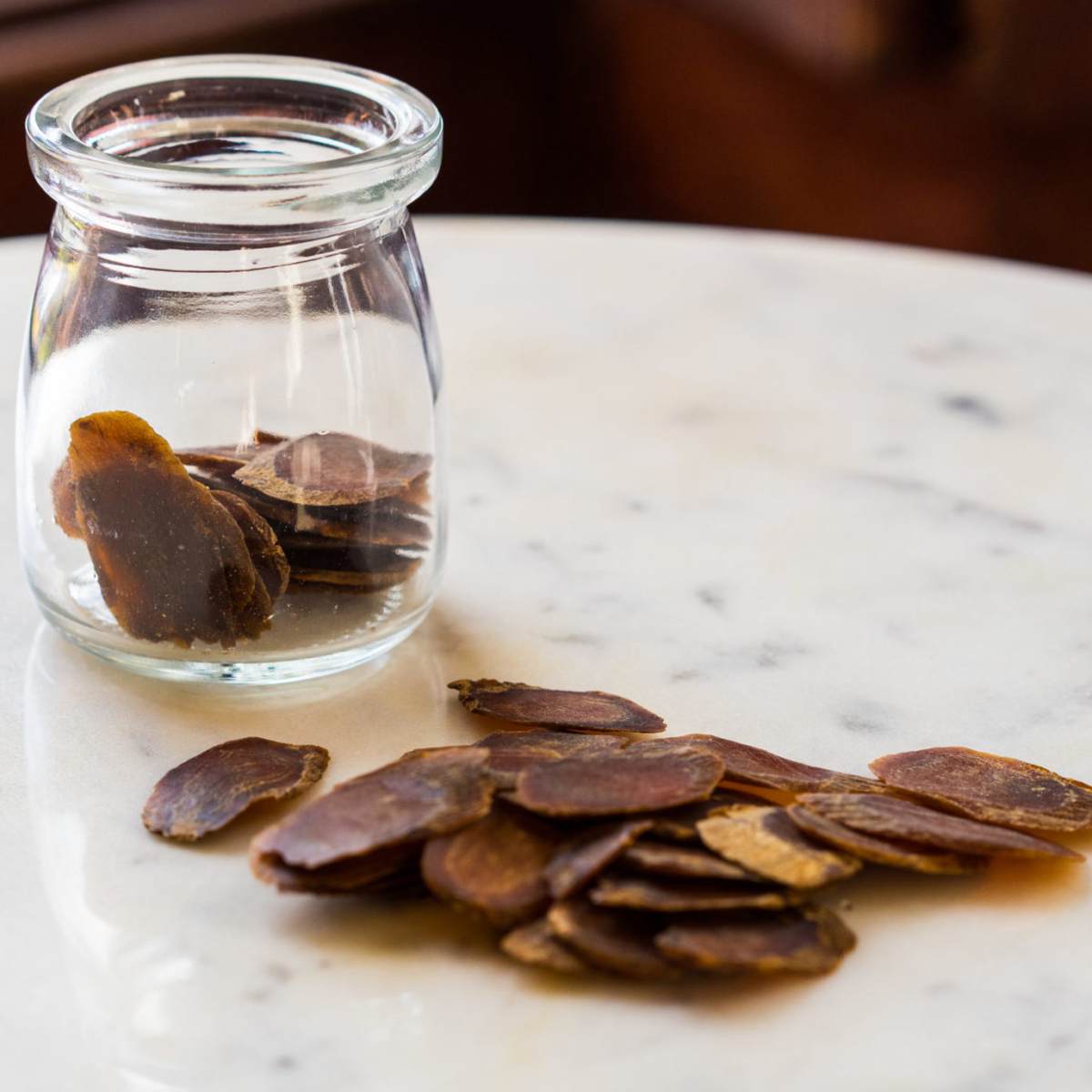
COMMON NAME (Chinese Name)
Chinese Red Ginseng (Ren Shen; Hongshen)
BOTANICAL NAME
Panax Ginseng
USES
Chinese Ginseng is one of the great tonic remedies in TCM. It is used for depleted yuan qi (original qi), vanquished qi and a total depletion of the upright qi with yang collapse. This describes a person that is in shock, with a feeble pulse, shallow respiration, shortness of breath, and a cold sweat. Ren shen is an adaptogen which means it is nontoxic in normal doses. Like all adaptogens, it has anti-stress qualities that provide stabilizing effects on the neuroendocrine system, especially the HPA axis. Adaptogens like ginseng help to modulate and enhance the immune system and provide antioxidant nutrients.
Panax ginseng is a powerful anti-inflammatory and immunomodulatory supplement. That is, it not only can reduce inflammation due to both infection and injury; it also positively changes the functional capability and capacity of the user’s immune system. As a result, taking a regular ginseng supplement can help heal those who have experienced traumatic injury and exercise-induced muscle pain, improving the day-to-day quality of life of users. Expected health improvements from taking a regular ginseng supplement include diminished symptoms of depression, anxiety, general fatigue, insomnia, dizziness and headaches, and menopause. Plus, ginseng may also improve gastrointestinal health, making digestion more comfortable and regulating both metabolism and bowel function.
Panax ginseng is the steamed mature root of the Chinese ginseng plant, which also is the source of unprocessed white ginseng. Steaming turns the root red and enhances its warming abilities. It is categorized as an herb to tonify qi in Chinese medicine. It is classified as hot, sweet, and bitter and especially affects the Spleen, Lung, and Heart channels.
PREPARATION & ADMINISTRATION
Ren shen ginseng is one of the few herbs that is ever given as a simple, without other herbs., Ginseng supplements in TCM are created using the steamed root which is dried (then crushed or decocted). It’s important to note that there are three different types of ginseng available to consumers, with white (unsteamed) Panax ginseng being moderately potent, falling between American ginseng (Panax quinquefolium) and Ren Shen (also called Korean red ginseng) in its warming power. American ginseng tends to be the least warming and most suitable for the largest number of people. Ren shen, called either Chinese or Korean (steamed) Panax ginseng, on the other hand, has many restrictions on use, as it is the hottest and packs the most punch when taken as a supplement.
In a random controlled trial patients recovering from a heart attack who took Red Panax ginseng had substantial improvement in microvascular integrity as measured by coronary flow rescue (CFR). The patients who took Panax also had increased circulatory angiogenic cells and decreased inflammatory markers.
Red Panax ginseng is used in the treatment of diabetes mellitus. However, care must be taken as it will potentiate western diabetes medications and could potentially reduce blood sugar to dangerous levels. Transitioning should occur only under professional healthcare.
PRECAUTIONS
Chinese medicine prohibits the use of Ren shen to people who are constitutionally hot, dehydrated, bleeding or suffering from hypertension. It is never taken with green or black tea, radishes or its seeds, Allergies to ginseng have been reported. Caution should be used when taking Ginseng with:
-
- Alcohol
- Caffeine, especially from tea
- Furosemide (Lasix)
- Insulin (additive effect)
- Medications changed by the liver (Cytochrome P450 2D6 (CYP2D6) substrates)
- Medications for depression (MAOIs)
- Anti-diabetes Medications (additive effect)
- Immunosuppressants
- Anticoagulant / Antiplatelet drugs
- Stimulant drugs
- Warfarin (Coumadin)
You should consult with a certified herbalist, physician or other qualified healthcare professional before taking Chinese Red Ginseng.
REFERENCES
Acupuncture.Com – Ginseng – A Guide for Consumers
Ahn, C.M., Hong, S.J., et al, Red Ginseng Extract Improves Coronary Flow Reserve and Increases Absolute Numbers of Various Circulating Angiogenic Cells in Patients with First St-Segment Elevation Acute Myocardial Infarction, Phytother Res,2011;25:239-4
Chen, I-J, Chang, M-Y, et al, Korean Red Ginseng Improves Blood Pressure Stability in Patients With Intradialytic Hypotension, Evid Based Complement Alternat Med, 2012 May 8;2012:595271, doi:10.1155/2012/595271
Kamwo Herbguide “Ren Shen” https://www.kamwo.com/escript/herbguide.php
Kim, Min-Hyun, and Hyeyoung Kim. “Ginseng and Gastrointestinal Protection.” Gastrointestinal Tissue, Academic Press, 9 June 2017
Nordqvist, Joseph. “Ginseng: Health Benefits, Facts, and Research.” Medical News Today, MediLexicon International, 20 Sept. 2017
“Panax Ginseng: Uses, Side Effects, Interactions, Dosage, and Warning.” WebMD, WebMD
Park, Byoung-Gun, et al. “Potentiation of Antioxidative and Anti-Inflammatory Properties of Cultured Wild Ginseng Root Extract through Probiotic Fermentation.” The Journal of Pharmacy and Pharmacology, U.S. National Library of Medicine, Mar. 2013
Riaz, Muhammad, et al. “Ginseng: A Dietary Supplement as Immune-Modulator in Various Diseases.” Trends in Food Science & Technology, Elsevier, 9 Nov. 2018
Winston, David, et Maimes, Stephen. Adaptogens: Herbs for Strength, Stamina, and Stress Relief 2nd Edition. Healing Arts Press. 27 Sept. 2019 pp152-192
